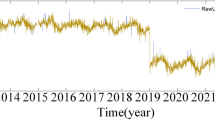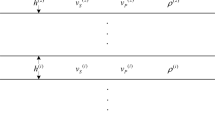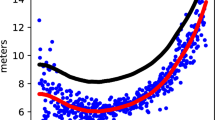Abstract
A geoid is a reference surface for orthometric height computed by the Stokes integral, and the error caused by truncating the integral into a limit area can be regarded as a bias. Early on, Molodensky modified the Stokes formula by decreasing the numerical size of the truncation coefficient to reduce the bias, and Evans and Featherstone accelerated the bias convergence. In comparison, spectral combination and least-squares modification (LSM) account for terrestrial gravity and Earth gravity model (EGM) errors as a variance in modifying the Stokes formula. However, the spectral combination and unbiased LSM (ULSM) poorly consider the bias when minimizing the variance, and this issue can be overcome by introducing the two bias-reducing methods. A theorem, proven in this study, accelerates the convergence of the truncation coefficient and improves the Molodensky-type modification. The proposed spectral combination with reducing bias (SCRB) and variance-minimizing ULSM with reducing bias (VURB) mitigate the errors of terrestrial gravity and EGMs, and the bias converges faster by the theorem. Considering the internal correlation of gravity anomaly error, the regional solution is also derived for SCRB and VURB for local geoid determination. Additionally, two regularizers introduced in this study avoid the ill-conditioned problems of the coefficient matrices.











Similar content being viewed by others
Data availability
XGM2019e_2159 can be obtained from http://icgem.gfz-potsdam.de/tom_longtime.
References
Abdullah NA, Mahdzur MD, Sulaiman SA (2021) Numerical analysis of gravimetric geoid and geometrical geoid over peninsular Malaysia. In: 2021 IEEE 12th control and system graduate research colloquium (ICSGRC). https://doi.org/10.1109/ICSGRC53186.2021.9515303
Ågren J, Sjöberg LE, Kiamehr R (2009) The new gravimetric quasigeoid model KTH08 over Sweden. J Appl Geod 3(3):143–153. https://doi.org/10.1515/JAG.2009.015
Ågren J (2004) Regional geoid determination methods for the era of satellite gravimetry: numerical investigations using synthetic earth gravity models. Ph.D. thesis, KTH Royal Institute of Technology, Stockholm
Bjerhammar A (1973) Theory of errors and generalized matrix inverses. Elsevier Scientific Publishing Company, Amsterdam
De Witte L (1967) Truncation errors in the Stokes and Vening Meinesz formulae for different order spherical harmonic gravity terms. Geophys J R Astron Soc 12(5):449–464. https://doi.org/10.1111/j.1365-246X.1967.tb03125.x
Ellmann A (2004) The geoid for the Baltic countries determined by the least squares modification of Stokes’ formula. Ph.D. Thesis, KTH Royal Institute of Technology, Stockholm, 82
Ellmann A (2005a) Computation of three stochastic modifications of Stokes’s formula for regional geoid determination. Comput Geosci 31(6):742–755. https://doi.org/10.1016/j.cageo.2005.01.008
Ellmann A (2005b) On the numerical solution of parameters of the least squares modification of Stokes’ formula. In: Sansò PDF (ed) A window on the future of geodesy, no. 128 in international association of geodesy symposia. Springer, Berlin, pp 403–408. https://doi.org/10.1007/3-540-27432-4_69
Evans JD, Featherstone WE (2000) Improved convergence rates for the truncation error in gravimetric geoid determination. J Geod 74(2):239–248. https://doi.org/10.1007/s001900050282
Featherstone WE (2013) Deterministic, stochastic, hybrid and bandlimited modifications of Hotine’s integral. J Geod 87(5):487–500. https://doi.org/10.1007/s00190-013-0612-9
Featherstone WE, Evans JD, Olliver JG (1998) A Meissl-modified Vaníêk and Kleusberg kernel to reduce the truncation error in gravimetric geoid computations. J Geod 72(3):154–160. https://doi.org/10.1007/s001900050157
Hansen PC (1998) Rank-deficient and discrete ill-posed problems: numerical aspects of linear inversion. SIAM, Philadelphia
Heck B, Grüninger W (1987) Modification of Stokes’s integral formula by combining two classical approaches. In: Proceedings of the XIX IUGG general assembly, vol 2. Vancouver, Canada, pp 319–337
Heiskanen WA, Moritz H (1967) Physical geodesy. Freeman, San Francisco
Liang W, Li J, Xu X, Zhang S, Zhao Y (2020) A high-resolution earth’s gravity field model SGG-UGM-2 from GOCE, GRACE, satellite altimetry, and EGM2008. Engineering. https://doi.org/10.1016/j.eng.2020.05.008
Meissl P (1971) Preparations for the numerical evaluation of second order Molodensky-type formulas. Technical Report 163, The Ohio State University
Molodensky M, Eremeev V, Urkina M (1962) Methods for study of the external gravitation field and figure of the Earth. Translations from Russian, Jerusalem, Israel Program for Scientific Translations
Ostach OM (1970) On the procedure of astro-gravimetric levelling. Stud Geophys Geod 14(2):222–225. https://doi.org/10.1007/bf02585629
Paul NK (1973) A method of evaluating the truncation error coefficients for geoidal height. Bull Geod 110:413–425. https://doi.org/10.1007/BF02521951
Pavlis NK, Holmes SA, Kenyon SC, Factor JK (2012) The development and evaluation of the Earth Gravitational Model 2008 (EGM2008). J Geophys Res Solid Earth 117:B0440. https://doi.org/10.1029/2011JB008916
Sjöberg LE (1980a) Leastsquares combination ofsatellite and terrestrial data in physical geodesy. Ann Geophys 37(1):25–30
Sjöberg LE (1980b) Least squares combination of satellite harmonics and integral formulas in physical geodesy. Gerlands Beitr Geophys 89(5):371–377
Sjöberg LE (1981) Least squares combination of satellite and terrestrial data in physical geodesy. Ann Geophys 37(1):25–30
Sjöberg LE (1984) Least squares modification of Stokes’s and Vening Meinesz’s formulas by accounting for the truncation and potential coefficient errors. Manuscr Geod 9:209–229
Sjöberg LE (1991) Refined least-squares modification of Stokes formula. Manuscr Geod 16:367–375
Sjöberg LE (2003a) A computational scheme to model the geoid by the modified Stokes formula without gravity reductions. J Geod 77(7–8):423–432. https://doi.org/10.1007/s00190-003-0338-1
Sjöberg LE (2003b) A general model of modifying Stokes’ formula and its least-squares solution. J Geod 77(7–8):459–464. https://doi.org/10.1007/s00190-003-0346-1
Sjöberg LE (2003c) A solution to the downward continuation effect on the geoid determined by Stokes’ formula. J Geod 77(1–2):94–100. https://doi.org/10.1007/s00190-002-0306-1
Sjöberg LE (2004) A spherical harmonic representation of the ellipsoidal correction to the modified Stokes formula. J Geod 78(3):180–186. https://doi.org/10.1007/s00190-004-0378-1
Sjöberg LE (2005a) A discussion on the approximations made in the practical implementation of the remove–compute–restore technique in regional geoid modelling. J Geod 78:645–653. https://doi.org/10.1007/s00190-004-0430-1
Sjöberg LE (2005b) A local least squares modification to Stokes’s formula. Stud Geophys Geod 49(1):23–30. https://doi.org/10.1007/s11200-005-1623-7
Sjöberg LE (2007) The topographic bias by analytical continuation in physical geodesy. J Geod 81(5):345–350. https://doi.org/10.1007/s00190-006-0112-2
Sjöberg LE (2020) Unbiased least-squares modification of Stokes’ formula. J Geod 94:92. https://doi.org/10.1007/s00190-020-01405-4
Sjöberg LE, Hunegnaw A (2000) Some modifications of Stokes’s formula that account for truncation and potential coefficient errors. J Geod 74(2):232–238. https://doi.org/10.1007/s001900050281
Sjöberg LE, Nahavandchi H (2000) The atmospheric geoid effects in Stokes’ formula. Geophys J Int 140(1):95–100. https://doi.org/10.1046/j.1365-246x.2000.00995.x
Stokes GG (1849) On the variation of gravity at the surface of the Earth. Trans Cambr Philos Soc 8:672–695
Tikhonov AN (1963) Solution of incorrectly formulated problems and the regularization method. Soviet Math Dokl 4:1035–1038 (English translation of Dokl. Akad. Nauk. SSSR, 151: 501-504)
Tscherning C, Rapp R (1974) Closed covariance expressions for gravity anomalies, geoid undulations and deflections of the vertical implied by anomaly degree variance models. Department of Geodetic Science, Report No. 208
Vaníček P, Kleusberg A (1987) The Canadian Geoid—Stokesian approach. Manuscr Geod 12:86–98
Vaníček P, Sjöberg LE (1991) Reformulation of Stokes’s theory for higher than second-degree reference field and modification of integration kernels. J Geophys Res Solid Earth 96(B4):6529–6539. https://doi.org/10.1029/90JB02782
Wenzel HG (1981) Zur Geoidbestimmung durch Kombination von Schwereanomalien und einem Kugelfunktionsmodell mit Hilfe von Integralformeln. Z Vermess 106:102–111
Wenzel HG (1983) Geoid computation by least squares spectral combination using integral kernels. In: Proceedings of the international association of geodesy general meeting, Tokyo, Japan, pp 438–453
Wong L, Gore R (1969) Accuracy of geoid heights from modified Stokes kernels. Geophys J R Astron Soc 18(1):81–91. https://doi.org/10.1111/j.1365-246X.1969.tb00264.x
Xu P (1998) Truncated SVD methods for discrete linear ill-posed problems. Geophys J Int 135(2):505–514. https://doi.org/10.1046/j.1365-246X.1998.00652.x
Zhong LS, Li HQ, Wang B, Liu S, Qiong W (2023) A general model of RCR modification and its geoid determination. Surv Rev. https://doi.org/10.1080/00396265.2023.2218682
Zingerle P, Pail R, Gruber T, Oikonomidou X (2020) The combined global gravity field model XGM2019e. J Geod 94:66. https://doi.org/10.1007/s00190-020-01398-0
Acknowledgements
This work was funded by the National Key R&D Program of China (2022YFC3003402).
Author information
Authors and Affiliations
Contributions
All authors contributed to the study's conception and design. Conceptualization and methodology were performed by [LZ] and [QW], and the first draft of the manuscript was written by [LZ]. [QW] supported funding acquisition, and all authors commented on previous manuscript versions. All the authors have read and approved the final manuscript.
Corresponding author
Ethics declarations
Conflict of interest
The authors declare no conflicts of interest in this paper.
Appendix: Proof of the theorem
Appendix: Proof of the theorem
Proof
Definition the of operator.
and \({\nabla }^{m}{S}_{m}\left(x\right)={\nabla }^{m-2}{\nabla }^{2}{S}_{m}\left(x\right)\), so we can get \({\nabla }^{2}{P}_{n}\left(x\right)={\left[\left(1-{x}^{2}\right){P}_{n}^{\prime}\left(x\right)\right]}^{\prime}=-n\left(n+1\right){P}_{n}\left(x\right)\) and \({\nabla }^{m-1}{S}_{m}\left(t\right)={\nabla }^{m-1}{S}_{m}\left(-1\right)=0\) for \(i=0,1,\dots ,m\). Thus
When \(m\) is an odd number, integrating by parts produces
According to Taylor’s theorem,
where \({t}_{0}\in \left(t,x\right)\), we have
Substituting Eq. (43b) into Eq. (42), we obtain
Therefore, the order of \({Q}_{n}^{m}\) is obtained:
after using
with \({P}_{n}^{\prime}\left(x\right)\sim O\left(\sqrt{n}\right)\).
When \(m\) is an even number, integrating by parts yields
We obtain
Therefore, the order of \({Q}_{n}^{m}\) is
After using
with \({P}_{n}\left(x\right)\sim O\left(1/\sqrt{n}\right)\).
When \(m=-1\), it satisfies \({Q}_{n}^{-1}={Q}_{n}\). The truncation coefficient can be estimated as follows:
Thus, \({Q}_{n}^{m}\sim O\left({n}^{-m-\frac{5}{2}}\right)\) also holds at \(m=-1\).
Rights and permissions
Springer Nature or its licensor (e.g. a society or other partner) holds exclusive rights to this article under a publishing agreement with the author(s) or other rightsholder(s); author self-archiving of the accepted manuscript version of this article is solely governed by the terms of such publishing agreement and applicable law.
About this article
Cite this article
Zhong, L., Wu, Q. An improved Molodensky-type modification of the Stokes formula and reduced bias in the spectral combination and variance-minimizing ULSM. J Geod 97, 102 (2023). https://doi.org/10.1007/s00190-023-01786-2
Received:
Accepted:
Published:
DOI: https://doi.org/10.1007/s00190-023-01786-2




